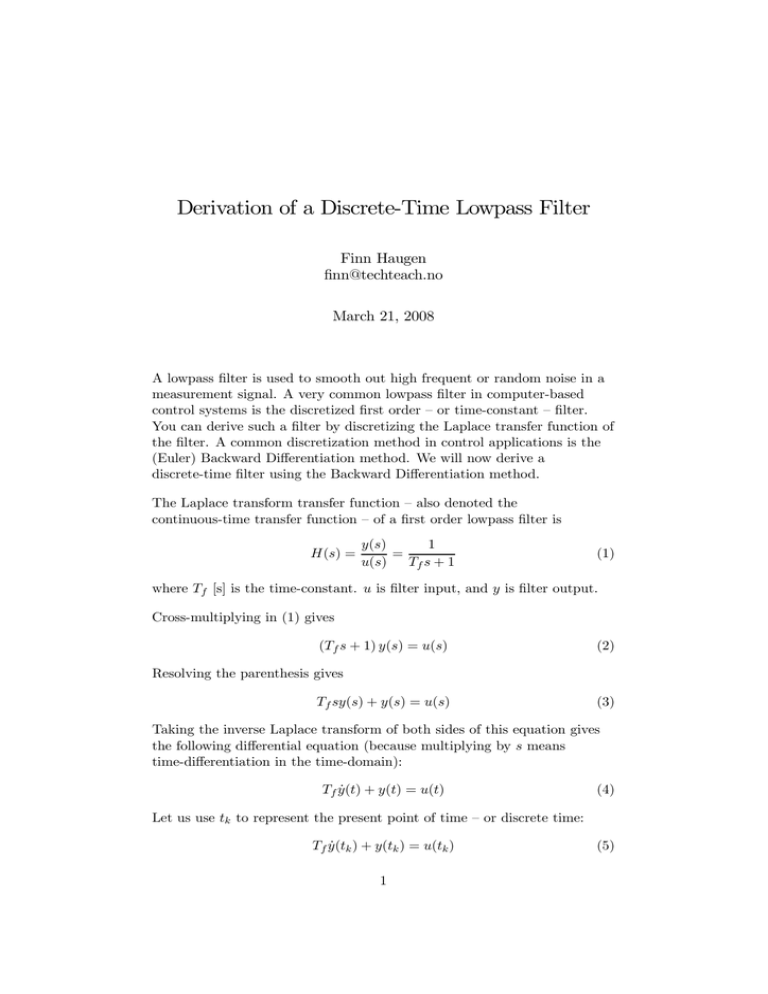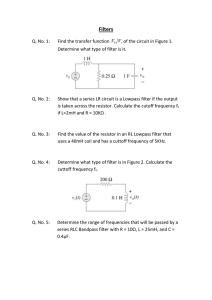Derivation of a Discrete-Time Lowpass Filter
advertisement

Derivation of a Discrete-Time Lowpass Filter Finn Haugen finn@techteach.no March 21, 2008 A lowpass filter is used to smooth out high frequent or random noise in a measurement signal. A very common lowpass filter in computer-based control systems is the discretized first order — or time-constant — filter. You can derive such a filter by discretizing the Laplace transfer function of the filter. A common discretization method in control applications is the (Euler) Backward Differentiation method. We will now derive a discrete-time filter using the Backward Differentiation method. The Laplace transform transfer function — also denoted the continuous-time transfer function — of a first order lowpass filter is H(s) = 1 y(s) = u(s) Tf s + 1 (1) where Tf [s] is the time-constant. u is filter input, and y is filter output. Cross-multiplying in (1) gives (Tf s + 1) y(s) = u(s) (2) Resolving the parenthesis gives Tf sy(s) + y(s) = u(s) (3) Taking the inverse Laplace transform of both sides of this equation gives the following differential equation (because multiplying by s means time-differentiation in the time-domain): Tf ẏ(t) + y(t) = u(t) (4) Let us use tk to represent the present point of time — or discrete time: Tf ẏ(tk ) + y(tk ) = u(tk ) 1 (5) y Exact slope, y(t k) y(tk ) y(t k ) y(tk-1 ) Slope with Euler’s Backward method tk-1 tk t h Figure 1: The (Euler) Backward Differentiation approximation to the timederivative Here we will substitute the Backward Differentiation approximation for the time derivative. This approximation is ẏ(tk ) ≈ y(tk ) − y(tk−1 ) h (6) It is illustrated in Figure 1. Tf y(tk ) − y(tk−1 ) + y(tk ) = u(tk ) h (7) Solving for y(tk ) gives y(tk ) = Tf h y(tk−1 ) + u(tk ) Tf + h Tf + h (8) which is commonly written as y(tk ) = (1 − a) y(tk−1 ) + au(tk ) (9) with filter parameter a= h Tf +h 2 (10) which has a given value once you have specified the filter time-constant Tf and the time-step h is given. (9) is the formula for the filter output. It is ready for being programmed. This filter is frequently denoted the exponentially weighted moving average (EWMA) filter, but we can just denote it a first order lowpass filter. According to (9) the present filter output y(tk ) is a function of the present filter input u(tk ) and the filter output at the previous discrete time, y(tk−1 ). Therefore, the filter output must be stored in the program so that it is available at the following execution if the filter algorithm. It is important that the filter time-step h is considerably smaller than the filter time-constant, otherwise the filter may behave quite differently from the original continuous-time filter (1) from which it is derived. h should be selected as Tf (11) h≤ 5 3


